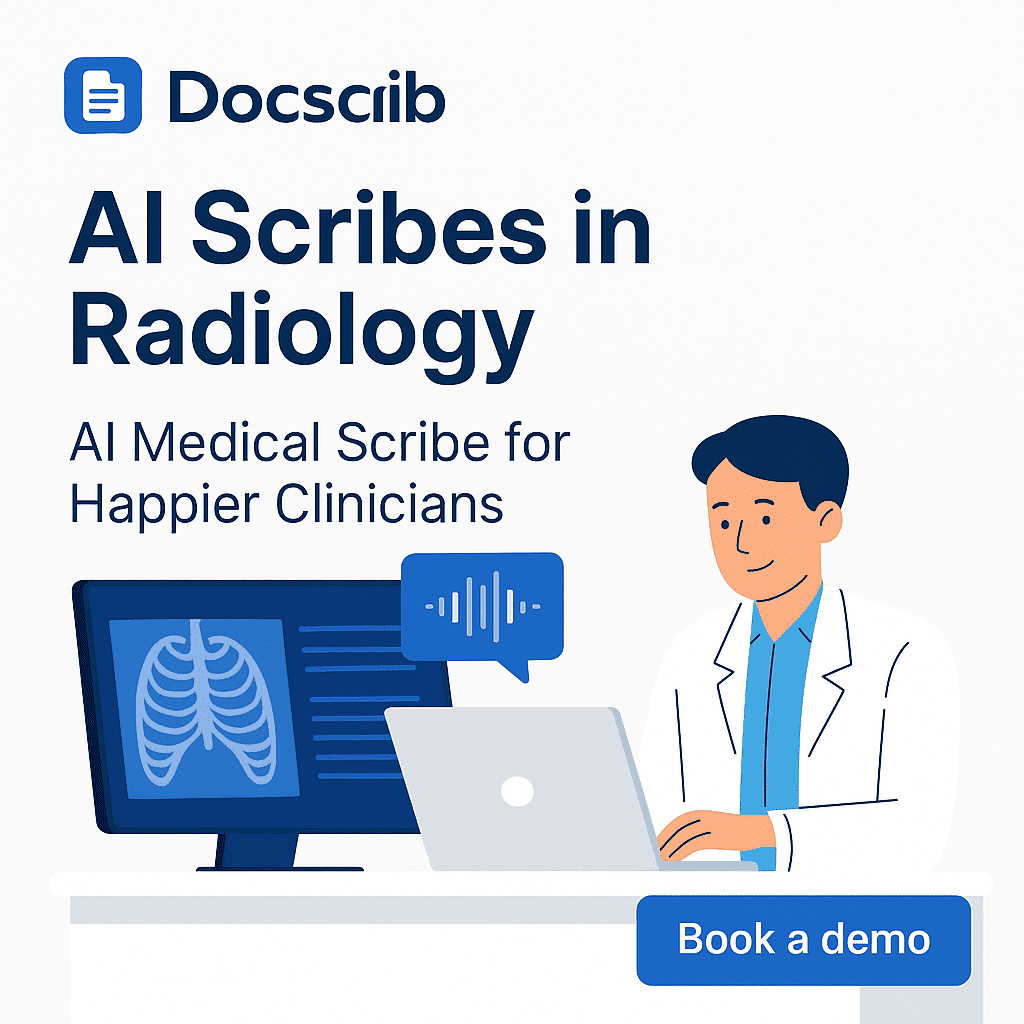Updated on: July 2, 2025
Radiologists work behind the scenes, interpreting critical findings that shape patient outcomes across the healthcare system. But while the imaging may be digital, the documentation process remains painfully manual and repetitive.
From detailed reads to structured impressions, charting consumes hours of a radiologist’s day — and often leads to fatigue, errors, and after-hours work.
Enter AI scribes in radiology.
DocScrib is an AI-powered medical scribe that listens, understands, and auto-generates clinical documentation based on your dictation — in real-time. Designed specifically for high-volume, high-precision environments like radiology, it reduces report turnaround times and improves workflow efficiency.
⚡ Faster reports. More accurate notes. Less burnout. That’s the power of Docscrib in radiology.
The Documentation Bottleneck in Radiology
Radiologists face immense pressure to produce detailed, accurate, and standardized reports for:
-
CT, MRI, and ultrasound scans
-
Interventional procedures
-
Nuclear medicine imaging
-
Emergency reads and trauma protocols
-
Routine X-rays and screening exams
Every report must be:
-
Precise and complete
-
Structured by modality
-
ICD/CPT-coded correctly
-
Communicated to the referring provider
-
Archived in the PACS/EHR system
This results in:
-
Repetitive reporting fatigue
-
Delays in critical findings communication
-
High risk of copy-paste errors
-
After-hours dictation clean-up
-
Increasing burnout
What Is an AI Medical Scribe for Radiologists?
An AI scribe uses voice recognition and natural language processing (NLP) to listen to radiologists’ speech during or after image review and generate structured, readable, and accurate reports.
With DocScrib, radiologists can:
-
Dictate naturally
-
Generate impression summaries in real time
-
Avoid redundant phrasing or formatting
-
Export directly to PACS/EHR
Whether you’re reporting a lung nodule, a fractured clavicle, or an incidental adrenal lesion, DocScrib adapts to your voice, your modality, and your reporting standards.
How Docscrib Transforms Radiology Workflows
1. Real-Time Report Generation
Speak naturally — DocScrib captures your clinical language, then generates:
-
Study details
-
Findings by anatomical section
-
Impressions and recommendations
-
Follow-up intervals
🖥️ Example:
“CT abdomen shows 3.1 cm low-attenuation lesion in liver segment VII, consistent with hemangioma. No biliary dilatation. Gallbladder unremarkable.”
DocScrib auto-generates:
-
Findings: Liver: 3.1 cm lesion in segment VII, likely hemangioma
-
Impression: Benign hepatic hemangioma. Recommend ultrasound in 12 months
2. Specialty-Specific Language Modeling
DocScrib understands complex radiologic terms like:
-
Ground-glass opacities
-
Rim-enhancing abscess
-
BIRADS classifications
-
T1/T2 signal characteristics
-
Vascular flow dynamics
-
Radiologic-pathologic correlation
This ensures minimal edits, maximum efficiency, and complete clarity for referring physicians.
3. Increased Report Volume and Reduced TAT
Radiology departments using Docscrib report:
-
35–50% faster report turnaround times
-
More scans read per hour
-
Improved communication with clinicians
-
Fewer documentation errors flagged during QA
💬 “DocScrib lets me focus on interpretation, not typing. I clear my list faster, with more confidence.” — Radiologist, Academic Health System
4. Works Seamlessly with PACS & EHR Systems
DocScrib integrates with your existing:
-
PACS systems
-
Radiology Information Systems (RIS)
-
EHR templates (Epic, Cerner, etc.)
-
Dictation and voice command workflows
Whether you’re on desktop or tablet, Docscrib adapts to your tools, your templates, and your workflow.
Docscrib vs Other AI Medical Scribes
| Feature | DocScrib | Soaper | NoteMD | Freed | ChartNote |
|---|---|---|---|---|---|
| Radiology NLP Engine | ✅ Yes | ❌ No | ❌ No | ❌ No | ❌ No |
| Structured reporting support | ✅ Built-in | ❌ No | ❌ No | ❌ No | ❌ No |
| PACS/EHR integration | ✅ Seamless | ❌ No | ✅ Partial | ✅ Partial | ✅ Some |
| Real-time ambient listening | ✅ Yes | ✅ Partial | ❌ No | ✅ Yes | ❌ No |
| Specialty-specific formatting | ✅ Yes | ❌ No | ❌ No | ❌ No | ❌ No |
📈 See how Docscrib fits your radiology workflow
👉 Book your free personalized demo →
FAQs
Is Docscrib HIPAA compliant?
Yes. DocScrib is HIPAA-compliant, SOC 2 certified, and built with healthcare-grade security and encryption protocols.
Does Docscrib support interventional radiology?
Yes. DocScrib can document:
-
Pre-procedure checklists
-
Fluoroscopic guidance
-
Intra-procedural findings
-
Post-op impressions
-
Follow-up and consent verification
Can I customize report templates?
Absolutely. You can upload existing macros, or let Docscrib learn your report formatting preferences and apply them automatically.
Final Thoughts: Radiology Deserves Smarter Documentation
Radiologists are under pressure to read faster, document cleaner, and report more — all without compromising accuracy.
With AI scribes in radiology, Docscrib delivers:
-
Instant documentation
-
Custom reports
-
Workflow harmony
-
Happier clinicians
If you’re ready to spend less time charting and more time interpreting, it’s time to meet DocScrib.
